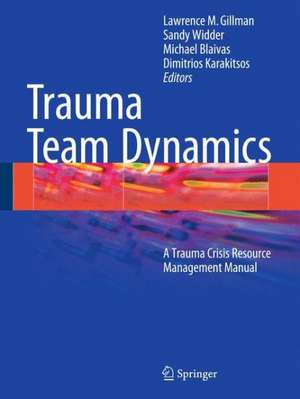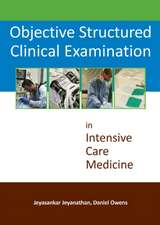Trauma Team Dynamics: A Trauma Crisis Resource Management Manual
Editat de Lawrence M. Gillman, Sandy Widder, Michael Blaivas MD, Dimitrios Karakitsosen Limba Engleză Paperback – 13 noi 2015
Crisis resource management (CRM) is integral to the way that we manage ourselves, team members, and patients during emergency situations. It is essentially the ability to translate knowledge of what needs to be done into effective actions during a crisis situation. Building on the revolutionary American College of Surgeons Advanced Trauma Life Support (ATLS®) course, Trauma Team Dynamics illustrates the integration of the principles of CRM to team dynamics throughout the resuscitation –from the scene, through pre-hospital care and transport, to the trauma bay, and finally to definitive care and beyond.
The editors and contributors are international experts in trauma, critical care, emergency medicine, nursing, respiratory therapy,and pre-hospital care and include NASA- and United States military-affiliated experts. Trauma Team Dynamics is intended for use as both a day-to-day clinical resource and a reference text, and includes self-assessment questions as well as guidance on CRM curriculum design and implementation.
Preț: 1378.97 lei
Preț vechi: 1451.54 lei
-5% Nou
Puncte Express: 2068
Preț estimativ în valută:
263.90€ • 274.50$ • 217.86£
263.90€ • 274.50$ • 217.86£
Carte tipărită la comandă
Livrare economică 10-16 aprilie
Preluare comenzi: 021 569.72.76
Specificații
ISBN-13: 9783319165851
ISBN-10: 3319165852
Pagini: 645
Ilustrații: XVIII, 329 p. 55 illus., 37 illus. in color.
Dimensiuni: 210 x 279 x 17 mm
Greutate: 9.49 kg
Ediția:1st ed. 2016
Editura: Springer International Publishing
Colecția Springer
Locul publicării:Cham, Switzerland
ISBN-10: 3319165852
Pagini: 645
Ilustrații: XVIII, 329 p. 55 illus., 37 illus. in color.
Dimensiuni: 210 x 279 x 17 mm
Greutate: 9.49 kg
Ediția:1st ed. 2016
Editura: Springer International Publishing
Colecția Springer
Locul publicării:Cham, Switzerland
Public țintă
Professional/practitionerCuprins
CONTENTS.- Dedication.- Foreword.- Preface.- Part 1: Trauma Team Preparation.- 1. The Genesis of Crew Resource Management: The NASA Experience.- 2. Crisis Resource Management Training in Trauma.- 3. Leadership Theories, Skills and Application.- 4. Teamwork and Communication in Trauma.- 5. Situational Awareness and Human Performance in Trauma.- Part 2: Trauma Team Design.- 6. Paramedical and Non-medical Personnel.- 7. Transport Medicine.- 8. Trauma Team Structure and Organization.- 9. Interprofessional Trauma Team Roles.- 10. The Trauma Bay Environment.- 11. Quality Improvement and Trauma Quality Indicators.- 12. Putting it all Together: Quality Control in Trauma Team Training.- Part 3: Trauma Resuscitation.- 13. Trauma Resuscitation.- 14. Damage Control Resuscitation.- 15. Damage Control─From Principles to Practice.- 16. Trauma Team Decision Making.- 17. Emergency Critical Care Procedures.- Part 4: Specialized Trauma Populations.- 18.Trauma in the Pediatric Patient.- 19. Trauma in Pregnancy.- 20. Medical Comorbidities and Trauma.- Part 5: Emergency Ultrasound and Trauma Imaging.- 21. Basic Trauma Ultrasound.- 22. Trauma Ultrasound: Beyond the FAST Examination.- 23. Telemedicine and Future Innovations.- 24. Imaging in the Stable Trauma Patient.- Part 6: Tactical Emergency and Disaster Medicine.- 25. Disaster Medicine.- 26. The Multi-Casualty Trauma.- 27. Critical Incident Team Dynamics and Logistics.- 28. Terrorism and Urban Trauma.- 29. Tactical Emergency Medicine, Procedures and Point-of-Care Evaluation in Austere Environments.- 30. Trauma in Austere Environments.- Cold Injury and Hypothermia.- 31. War Zones and Biologic Warfare.- 32. Nuclear Injuries.- 33. Trauma and Surgical Capabilities for Space Exploration.- Part 7: Trauma Team Education.- 34. Designing a Simulation Curriculum.- 35. Designing Multidisciplinary Simulations.- 36. Constructive Debriefing for Trauma Team Education.-
37.Program Evaluation and Assessment of Learning.- 38. Teaching Technical and Procedural Skills.- 39. Multiple Choice Review Questions.- Appendix A.- Appendix B.
37.Program Evaluation and Assessment of Learning.- 38. Teaching Technical and Procedural Skills.- 39. Multiple Choice Review Questions.- Appendix A.- Appendix B.
Recenzii
“Trauma Team Dynamics is an appropriate expansion on the principles of ATLS. … An appropriate audience includes senior trainees or providers in emergency medicine, anesthesiology, orthopedics, or trauma surgery. … Each chapter has an adequate reference list with citations dating to within one to two years of publication as well as classic works from decades ago. … all are well written and providers of all degrees of sophistication will find helpful information here.” (David J. Dries, Doody’s Book Reviews, July, 2016)
Notă biografică
Lawrence M. Gillman, MD MMedEd FRCSC
Department of Surgery
University of Manitoba
Winnipeg, Canada
Sandy Widder, MD FRCSC FACS MHA MSc QIPS
Department of Surgery
University of Alberta
Edmonton, Canada
Michael Blaivas, MD
Professor of Medicine
School of Medicine
University of South Carolina
Columbia, SC USA
Department of Emergency Medicine
St. Francis Hospital
Columbus, GA USA
Dimitrios Karakitsos MD PhD DSc
Department of Internal Medicine
University of South Carolina, School of Medicine
Columbia, SC USA
Division of Critical Care, Department of Anesthesiology
Keck School of Medicine
University of Southern California
Los Angeles, CA USA
Department of Surgery
University of Manitoba
Winnipeg, Canada
Sandy Widder, MD FRCSC FACS MHA MSc QIPS
Department of Surgery
University of Alberta
Edmonton, Canada
Michael Blaivas, MD
Professor of Medicine
School of Medicine
University of South Carolina
Columbia, SC USA
Department of Emergency Medicine
St. Francis Hospital
Columbus, GA USA
Dimitrios Karakitsos MD PhD DSc
Department of Internal Medicine
University of South Carolina, School of Medicine
Columbia, SC USA
Division of Critical Care, Department of Anesthesiology
Keck School of Medicine
University of Southern California
Los Angeles, CA USA
Textul de pe ultima copertă
This is the first book exploring the unique dynamics created by a multidisciplinary trauma team and how crisis management strategies can improve teamwork and communication and, potentially, improve patient resuscitation outcomes.
Crisis resource management (CRM) is integral to the way that we manage ourselves, team members, and patients during emergency situations. It is essentially the ability to translate knowledge of what needs to be done into effective actions during a crisis situation. Building on the revolutionary American College of Surgeons Advanced Trauma Life Support (ATLS®) course, Trauma Team Dynamics illustrates the integration of the principles of CRM to team dynamics throughout the resuscitation – from the scene, through pre-hospital care and transport, to the trauma bay, and finally to definitive care and beyond.
The editors and contributors are international experts in trauma, critical care, emergency medicine, nursing, respiratory therapy, and pre-hospital care and include NASA- and United States military-affiliated experts. Trauma Team Dynamics is intended for use as both a day-to-day clinical resource and a reference text, and includes self-assessment questions as well as guidance on CRM curriculum design and implementation.
Crisis resource management (CRM) is integral to the way that we manage ourselves, team members, and patients during emergency situations. It is essentially the ability to translate knowledge of what needs to be done into effective actions during a crisis situation. Building on the revolutionary American College of Surgeons Advanced Trauma Life Support (ATLS®) course, Trauma Team Dynamics illustrates the integration of the principles of CRM to team dynamics throughout the resuscitation – from the scene, through pre-hospital care and transport, to the trauma bay, and finally to definitive care and beyond.
The editors and contributors are international experts in trauma, critical care, emergency medicine, nursing, respiratory therapy, and pre-hospital care and include NASA- and United States military-affiliated experts. Trauma Team Dynamics is intended for use as both a day-to-day clinical resource and a reference text, and includes self-assessment questions as well as guidance on CRM curriculum design and implementation.
Caracteristici
First-of-its-kind book on application of crisis resource management (CRM) principles to team dynamics during emergency trauma situations Uniquely practical, comprehensive approach to damage control resuscitation Key Points” at end of each chapter provide a check list of essential information Conventional and point-of-care imaging of the trauma patient, including emerging techniques Tips on creating a CRM curriculum Self-assessment questions for each chapter International experts in trauma, critical care, emergency medicine, nursing, respiratory therapy, and pre-hospital care (including NASA- and United States military-affiliated experts)











